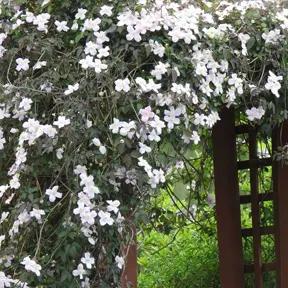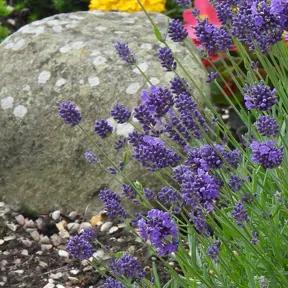Victory French Lavender Plants
Purple French Butterfly Lavender
- Small, dark purple flowers with long, lighter "ears"
- Height: 60cm
- Scent: Strong lavender scent
- Flowering: May to July/August
- Evergreen, grey-green aromatic foliage
- Drought resistant, grows on the coast
- Lavandula stoechas
- RHS Plants for Pollinators
Buying Victory French Lavender Online
Mid-Purple French Butterfly Wing Lavender
Latin Name: Lavandula stoechas 'Victory'
Victory French lavender has small, dark purple flowers held on elegant, slender stems and topped with relatively long lilac-purple ‘wings’, which flutter in the breeze along with all the bees & butterflies they attract.
The grey-green evergreen foliage is strongly scented, and the plants themselves are quite compact compared to our other lavender varieties, up to around 60cm tall and wide, with flower spikes reaching up to a metre.
French lavender blooms earlier than its "English" angustifolia relatives, sometimes starting in May: if you deadhead it a little, you can extend its flowering into August, but June & July are its peak season.
Features
- Small, dark purple flowers with long, lighter "ears"
- Height: 60cm, 1 metre when in flower
- Scent: Strong lavender scent
- Flowering: May to July/August
- Evergreen, grey-green aromatic foliage
- Drought resistant, grows on the coast
- RHS Plants for Pollinators
Growing French Lavender
The RHS give it a hardiness rating of H4, the most tricky rating, meaning it will withstand an "average winter" down to around -5C without much damage.
Ideally, it wants a sheltered, sunny spot against a south-facing wall in most of the country outside the South West. In colder inland and Northern regions, we recommend growing it in pots that can either be moved into shelter in winter, or that receive heat from the house and can be covered up to make a cosy microclimate. For protection in the garden, horticultural fleece is good for rows, and buckets with ventilation holes in them, or large pots, should work for covering single plants.
Plant in sharply drained soil and full sun. If your soil’s heavy, dig in lots of grit and make a ridge or raised bed, or save yourself the trouble and grow it in pots.
Prune immediately after flowering.
Planting Companions for Victory Lavender
A group of Lavenders in terracotta pots of varying heights around a seated area has a simple and effective rhythm. It’s a classic path edging plant, where every time you brush past you’ll release a heavenly waft of perfume.
Combine it in sunny borders with other Mediterranean sun lovers such as thymes, rosemary, santolina, stachys and other later-flowering varieties of lavender, both purple and white, which will prolong the lavender season in your garden. It grey-green foliage will blend marvellously in a gravel garden.
Planting Instructions
How to plant French lavender
Choose a sheltered spot with as much light as possible. Improve the soil from the hole by removing roots, weeds, large stones and other rubbish and mixing in plenty of sharp sand or grit.
Position your lavender so its roots are spread out.
Then backfill the hole with mixed soil and grit/sharp sand, firming it gently as you go. Water in thoroughly.
Deadhead. Prune in late summer, and again in early spring if necessary. Avoid cutting into woody stems.
Did you know?
To Brits, this is French Lavender, probably because we have imported so much of it from the plantations of Provence down the years, and to an American it is Spanish Lavender, which is more accurate: its native range is Spain, North Africa and some other spots around the Mediterranean.
It is also known as Butterfly (there is another cultivar that bagged the name Papillon) or Bract Lavender due to the ornamental ears or wings (bracts) topping the flowers. The whole flower is edible as a colourful garnish on salads and desserts.
It's Summer Planting Season 2025

Pot Grown & Plug Plants Delivered

Direct from the Nursery Value

No more broken plants in the post!









